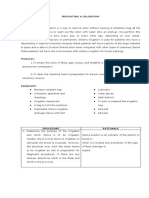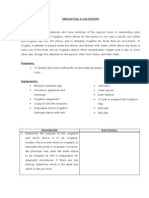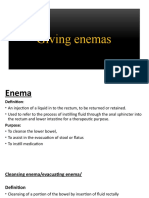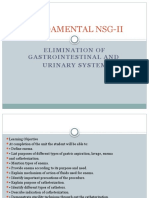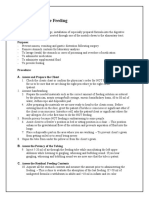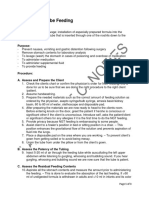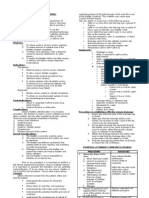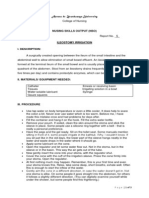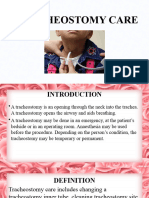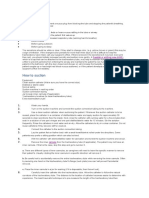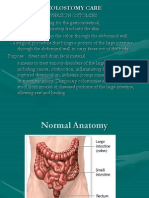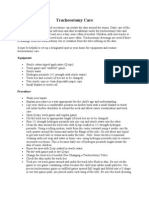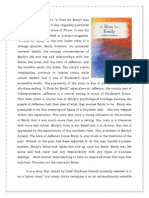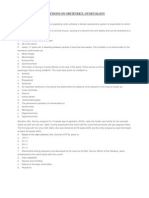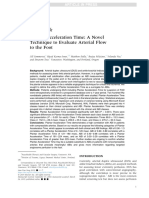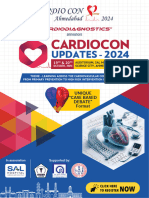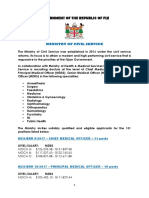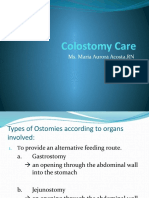Irrigating A Colostomy
Irrigating A Colostomy
Uploaded by
Grace NazarenoCopyright:
Available Formats
Irrigating A Colostomy
Irrigating A Colostomy
Uploaded by
Grace NazarenoOriginal Title
Copyright
Available Formats
Share this document
Did you find this document useful?
Is this content inappropriate?
Copyright:
Available Formats
Irrigating A Colostomy
Irrigating A Colostomy
Uploaded by
Grace NazarenoCopyright:
Available Formats
Irrigating a Colostomy
EQUIPMENTS Reservoir for irrigating fluids; irrigator bag or enema bag if irrigator bag not available Irrigating fluid: 500-1,500 mL lukewarm water or other solution prescribed by health care provider (Volume is titrated based on patient tolerance and results; average amount is 1,000 mL.) Irrigating tip: Cone tip or soft rubber catheter #22 or #24 with shield to prevent backflow of irrigating solution (Use only if cone not available) The cone is the preferred method to avoid possibility of bowel perforation.)Irrigation sleeve (long, largecapacity bag with opening at top to insert cone or catheter into stoma); available in different styles: Snap-on, self-adhering to skin, or held in place by belt Large tail closure Water-soluble lubricant. PROCEDURE: Nursing Action Preparatory phase 1.Explain the details of the procedure to the patient and answer any questions. Relieves anxiety and promotes compliance. 2. Select a consistent time, free from distractions. If the patient is learning to irrigate for bowel control, choose the time of day that will best fit into the patient's lifestyle. Establishes regularity. 3.Have the patient sit in front of the commode on chair or on the commode itself, providing privacy, and comfort. 4.Hang irrigating reservoir with prescribed solution so the bottom of the reservoir is approximately at the level of the patient's shoulder and above the stoma. Note: Colostomy irrigation may also be performed to empty the colon of its contents(feces, gas, mucus) before a diagnostic procedure or surgery and to cleanse the colon after fecal impaction removal or with constipation. Height of irrigation bag regulates pressure of irrigant. Performance phase 1. Remove pouch or covering from stoma, and apply irrigation sleeve, directing the open tail Allows water and feces to flow directly into commode. 2. Open tubing clamp on the irrigating reservoir to release a small amount of solution into the commode
Removes air from the setup; avoids air from being introduced into the colon, which can cause crampy pain. 3. Lubricate the tip of the cone/catheter, and gently insert into the stoma. Insert catheter no more than 3 inches (7.5 cm). Hold cone/shield gently, but firmly, against stoma to prevent backflow of water. Prevents intestinal perforation and irritation of mucous membranes. 4. If catheter does not advance easily, allow water to flow slowly while advancing catheter. NEVER FORCE CATHETER. Dilating the stoma with lubricated, gloved pinky finger may be necessary to direct cone/catheter properly. Slow rate relaxes bowel to facilitate passage of catheter. 5. Allow water to enter colon slowly over a 5- to10-minute period. If cramping occurs, slow flow rate or clamp tubing to allow cramping to subside. If cramping does not subside, remove cone/catheter to release contents. Cramping may occur from too rapid flow, cold water, excess solution, or colon ready to function. 6. Hold cone/shield in place 10 seconds after water is instilled, then gently remove cone/catheter from stoma.6.Discourages premature evacuation of fluid. 7. As feces and water flow down sleeve, periodically rinse sleeve with water. Allow 10-15 minutes for most of the returns, then dry sleeve tail and apply tail closure. 8. Leave sleeve in place for approximately 20more minutes while patient gets up and moves around. Ambulation stimulates peristalsis and completion of irrigation return. 9. When returns are complete, clean stomal area with mild soap and water; pat dry; reapply pouch or covering over stoma. Cleanliness and dryness promote comfort. Follow-up phase 1. Clean equipment with soap and water; dry and store in well-ventilated area. This will control odor and mildew, prolonging the life of equipment. 2. If applicable, the patient should use a pouch until the colostomy is sufficiently controlled It may take several months to establish control. The patient can then use mini pouch, stoma cap, or gauze covering as desired.
You might also like
- With Rationale 013 Irrigating A Colostomy Students Copy 1Document5 pagesWith Rationale 013 Irrigating A Colostomy Students Copy 1John Pearl Fernandez100% (1)
- Suctioning 160714115618Document18 pagesSuctioning 160714115618jothi100% (2)
- Colostomy ProcedureDocument2 pagesColostomy Proceduremarie100% (2)
- Irrigation of Colostomy - CharacteristicsofstomaDocument5 pagesIrrigation of Colostomy - CharacteristicsofstomaKenneth OpinaNo ratings yet
- Changing Fecal Pouching Colostomy)Document48 pagesChanging Fecal Pouching Colostomy)Champola Pola Camille BernardoNo ratings yet
- 8 Irrigating A ColostomyDocument5 pages8 Irrigating A ColostomyAnn Jalover PerezNo ratings yet
- Colostomy Care & IrrigationDocument18 pagesColostomy Care & Irrigationpbatongbakal100% (2)
- Colostomy Care IrrigationDocument18 pagesColostomy Care IrrigationCharlhyn BisnarNo ratings yet
- Colostomy IrrigationDocument3 pagesColostomy IrrigationJikko Verra GarciaNo ratings yet
- Performing Colostomy Irrigation: by O-Jay Jimenez, RN, MNDocument24 pagesPerforming Colostomy Irrigation: by O-Jay Jimenez, RN, MNJan Federick Bantay100% (1)
- Colostomy IrrigationDocument2 pagesColostomy IrrigationMallory FernandezNo ratings yet
- Insertion of TubesDocument29 pagesInsertion of Tubesqopcyrus10No ratings yet
- Administering EnemaDocument35 pagesAdministering Enemabajaoc100% (1)
- Catheterization and EnemaDocument49 pagesCatheterization and EnemakhaimahalenylenNo ratings yet
- GRP 9Document46 pagesGRP 942 Vcon Silpa SasiNo ratings yet
- Irrigating A ColostomyDocument1 pageIrrigating A Colostomyclaire yowsNo ratings yet
- Administering An Enema EQUIPMENT Prepackaged Enema or Enema Container DisposableDocument3 pagesAdministering An Enema EQUIPMENT Prepackaged Enema or Enema Container Disposablemarie100% (2)
- Chest Tube Nursing CareDocument1 pageChest Tube Nursing CareVanessa LadraNo ratings yet
- Nasogastric Tube InsertionDocument8 pagesNasogastric Tube InsertionPaulo ManitiNo ratings yet
- Giving EnemasDocument31 pagesGiving EnemasAbelNo ratings yet
- Colostomy CareDocument49 pagesColostomy Caregladz25100% (1)
- Ateneo de Zamboanga University College of Nursing NCM 112j RLEDocument3 pagesAteneo de Zamboanga University College of Nursing NCM 112j RLEsenyorakath0% (1)
- Urinary Catheterization Nursing ProcedureDocument6 pagesUrinary Catheterization Nursing ProcedureDencel BarramedaNo ratings yet
- Male CatheterizationDocument37 pagesMale CatheterizationJean Rynne BongaisNo ratings yet
- CatheterizationDocument43 pagesCatheterizationJen Tirapan100% (2)
- Chest DrainageDocument28 pagesChest DrainageCristy Guzman100% (1)
- SuctioningDocument31 pagesSuctioningmelanie silvaNo ratings yet
- CATHETERIZATIONDocument13 pagesCATHETERIZATIONSarah Uy Caronan100% (1)
- Urinary EliminationDocument9 pagesUrinary EliminationTuTitNo ratings yet
- Fundamental Nsg-IiDocument46 pagesFundamental Nsg-IiabiyotNo ratings yet
- NasoGastric Tube FeedingDocument3 pagesNasoGastric Tube FeedingSwati SharmaNo ratings yet
- CYSTOCLYSIS3Document9 pagesCYSTOCLYSIS3Alvin OccianoNo ratings yet
- Nasogastric Tube FeedingDocument3 pagesNasogastric Tube FeedingLawrence Cada NofiesNo ratings yet
- Nasogastric Tube InsertionDocument8 pagesNasogastric Tube InsertionMayaPopbozhikovaNo ratings yet
- Urinary CathDocument71 pagesUrinary Cathlouie roderosNo ratings yet
- Endotracheal Suctioning ProcedureDocument12 pagesEndotracheal Suctioning ProcedureStar Alvarez67% (3)
- CatheterizationDocument46 pagesCatheterizationJam Maj67% (6)
- 6 Urinary EliminationDocument5 pages6 Urinary EliminationkhautedameNo ratings yet
- Peritoneal DialysisDocument26 pagesPeritoneal DialysisKath LeenNo ratings yet
- Tracheostomy Tubesuctioning2 MikeDocument29 pagesTracheostomy Tubesuctioning2 MikeClaudia VillalunaNo ratings yet
- Nusing Skills Output (Nso)Document3 pagesNusing Skills Output (Nso)leroux2890No ratings yet
- Bowel GuidelineDocument13 pagesBowel GuidelineRiza FadzilahNo ratings yet
- Colostomy IrrigationDocument3 pagesColostomy IrrigationAlyssa Joyce TanNo ratings yet
- Actual ManagementDocument7 pagesActual ManagementApOlle Defiesta - DOminguezNo ratings yet
- Suctioning Jay VIllasoto BSN 3Document3 pagesSuctioning Jay VIllasoto BSN 3Jay VillasotoNo ratings yet
- TracheostomycareDocument17 pagesTracheostomycareMwamba ChikondeNo ratings yet
- TRACHEOSTOMYDocument4 pagesTRACHEOSTOMYPrecious BlessingNo ratings yet
- Colostomy IrrigationDocument2 pagesColostomy IrrigationAudreySalvadorNo ratings yet
- When To Suction: Swedish or Artificial Nose (HME)Document2 pagesWhen To Suction: Swedish or Artificial Nose (HME)Liezl Mae MacaraegNo ratings yet
- Alternative Feeding MethodsDocument10 pagesAlternative Feeding MethodsMyrrha Velarde Filomeno TaganasNo ratings yet
- GIT Checklist With RationaleDocument5 pagesGIT Checklist With RationaleTeal OtterNo ratings yet
- Tracheostomy SuctioningDocument59 pagesTracheostomy SuctioningMaan LapitanNo ratings yet
- Colostomy Care1Document25 pagesColostomy Care1Ely FuaNo ratings yet
- Tracheostomy CareDocument17 pagesTracheostomy Caresam100% (2)
- Male Catheterization (Indwelling)Document43 pagesMale Catheterization (Indwelling)Dan Floyd FernandezNo ratings yet
- The Care and Feeding of Children - A Catechism for the Use of Mothers and Children’s NursesFrom EverandThe Care and Feeding of Children - A Catechism for the Use of Mothers and Children’s NursesNo ratings yet
- The Care and Feeding of Children - A Catechism for the Use of Mothers and Children's NursesFrom EverandThe Care and Feeding of Children - A Catechism for the Use of Mothers and Children's NursesNo ratings yet
- The Care and Feeding of Children - A Catechism for the Use of Mothers and Children’s NursesFrom EverandThe Care and Feeding of Children - A Catechism for the Use of Mothers and Children’s NursesNo ratings yet
- Rules and Directions for the Employment of Injections in Various DiseasesFrom EverandRules and Directions for the Employment of Injections in Various DiseasesNo ratings yet
- The Care and Feeding of Children: A Catechism for the Use of Mothers and Children's NursesFrom EverandThe Care and Feeding of Children: A Catechism for the Use of Mothers and Children's NursesNo ratings yet
- Samuel Taylor Coleridge: William Wordsworth (1770-1850)Document3 pagesSamuel Taylor Coleridge: William Wordsworth (1770-1850)Grace NazarenoNo ratings yet
- Amoebiasis Case StudyDocument12 pagesAmoebiasis Case StudyGrace NazarenoNo ratings yet
- Learning Feedback Diary Rle Group 17 AUGUST 23 & 30, 2010Document2 pagesLearning Feedback Diary Rle Group 17 AUGUST 23 & 30, 2010Grace Nazareno0% (1)
- Adrenal Anatomy 101Document44 pagesAdrenal Anatomy 101Grace NazarenoNo ratings yet
- FX of Distal HumerusDocument76 pagesFX of Distal HumerusGrace NazarenoNo ratings yet
- Critical Care Nursing: Debbie L. DempelDocument37 pagesCritical Care Nursing: Debbie L. DempelGrace NazarenoNo ratings yet
- Hepatobiliary DiseaseDocument27 pagesHepatobiliary DiseaseGrace NazarenoNo ratings yet
- A Rose For EmilyDocument4 pagesA Rose For EmilyGrace NazarenoNo ratings yet
- What Are Adult Brain and Spinal Cord TumorsDocument27 pagesWhat Are Adult Brain and Spinal Cord TumorsGrace NazarenoNo ratings yet
- By Kane Guthrie: Emergency Nursing of The Trauma PatientDocument52 pagesBy Kane Guthrie: Emergency Nursing of The Trauma PatientGrace NazarenoNo ratings yet
- 5 Common: EmergenciesDocument19 pages5 Common: EmergenciesGrace NazarenoNo ratings yet
- Hematology #Hematocrit-M - 0.40-0.54 F - 0.37-0.47 #Hemoglobin - M - 140-160g/L - F - 120-140g/LDocument1 pageHematology #Hematocrit-M - 0.40-0.54 F - 0.37-0.47 #Hemoglobin - M - 140-160g/L - F - 120-140g/LGrace NazarenoNo ratings yet
- SDLHFDocument1 pageSDLHFGrace NazarenoNo ratings yet
- 2 Questions On Obstetrics, GyneDocument4 pages2 Questions On Obstetrics, GyneGrace NazarenoNo ratings yet
- Nursing Care Plan: Cues Nursing Diagnosis Objectives Nursing Interventions Rationale EvaluationDocument1 pageNursing Care Plan: Cues Nursing Diagnosis Objectives Nursing Interventions Rationale EvaluationGrace NazarenoNo ratings yet
- What Are Ketone BodiesDocument10 pagesWhat Are Ketone BodiesGrace NazarenoNo ratings yet
- Congenital Heart DefectsDocument9 pagesCongenital Heart DefectsSHAMAE FAITH FARRENNo ratings yet
- Chest TraumaDocument39 pagesChest Traumayared getachewNo ratings yet
- DVT Case StudyDocument3 pagesDVT Case StudyCrystal B Costa78No ratings yet
- Cardiovascular Catheterization and InterventionDocument742 pagesCardiovascular Catheterization and InterventionArtur TarsaNo ratings yet
- Contentions Et Tractions TF - Fr.enDocument48 pagesContentions Et Tractions TF - Fr.enchaib boudabNo ratings yet
- Case-Presentation OTITIS MEDIADocument22 pagesCase-Presentation OTITIS MEDIAJean nicole GaribayNo ratings yet
- EHS and AHS Guidelines For Treatment of Primary VentralDocument12 pagesEHS and AHS Guidelines For Treatment of Primary VentralGeraldNo ratings yet
- Common Equipment Use in Health AssessmentDocument19 pagesCommon Equipment Use in Health AssessmentLOVELY SHANE ROSARIONo ratings yet
- CH 12Document25 pagesCH 12nhieuntnNo ratings yet
- Fascia Iliaca Block (FIB)Document16 pagesFascia Iliaca Block (FIB)pulickal03No ratings yet
- Lower Resp TractDocument32 pagesLower Resp TractTakshikaNo ratings yet
- Esophageal Cancer - Wikipedia, The Free EncyclopediaDocument11 pagesEsophageal Cancer - Wikipedia, The Free EncyclopediaAslesa Wangpathi PagehgiriNo ratings yet
- Translation of Medical Terms 2 Ppt - ١٢٠٤١٢Document46 pagesTranslation of Medical Terms 2 Ppt - ١٢٠٤١٢Dodo HadiNo ratings yet
- Anatomy of The Cardiovascular SystemDocument75 pagesAnatomy of The Cardiovascular SystemM RazzaqNo ratings yet
- Descrição Da Técnica - Sommerset2019Document7 pagesDescrição Da Técnica - Sommerset2019José Sergio Garcia de AlmeidaNo ratings yet
- Complication On Labor and DeliveryDocument5 pagesComplication On Labor and DeliveryMeryville JacildoNo ratings yet
- Cardiocon 2024 AgendaDocument15 pagesCardiocon 2024 AgendaAbhimanyu SinghNo ratings yet
- Diagnostic Accuracy of Pubic Symphysis Ultrasound in The Detection of Unstable Pelvis in Polytrauma Patients During e FAST - The Value of FAST-PLUS Protocol. A Preliminary ExperienceDocument6 pagesDiagnostic Accuracy of Pubic Symphysis Ultrasound in The Detection of Unstable Pelvis in Polytrauma Patients During e FAST - The Value of FAST-PLUS Protocol. A Preliminary ExperienceJorge MéndezNo ratings yet
- UE 1 Clavicle FracturesDocument46 pagesUE 1 Clavicle FracturesDavidBeatonComuladaNo ratings yet
- Activity 5 Venipuncture Procedures: Judy Ann Nichole A. Dionio, RMTDocument66 pagesActivity 5 Venipuncture Procedures: Judy Ann Nichole A. Dionio, RMTAngelica Camille B. AbaoNo ratings yet
- Surgery MCQDocument49 pagesSurgery MCQjhuiNo ratings yet
- Circulatory System QuizDocument5 pagesCirculatory System QuizJohn LesterNo ratings yet
- MicrosurgeryDocument20 pagesMicrosurgeryNyein Chan AungNo ratings yet
- Cerebral AngiographyDocument3 pagesCerebral AngiographyBiway RegalaNo ratings yet
- Fiji Ministry of Health Requirements For April 2017Document2 pagesFiji Ministry of Health Requirements For April 2017Ahmed KassemNo ratings yet
- Colostomy Care: Ms. Maria Aurora Acosta, RNDocument23 pagesColostomy Care: Ms. Maria Aurora Acosta, RNFely StaAnaNo ratings yet
- Laf - Medical X-Ray FacilityDocument3 pagesLaf - Medical X-Ray FacilityDonabel RamosNo ratings yet
- JC 1Document20 pagesJC 1Dimple JethwaniNo ratings yet
- Abnormal LaborDocument114 pagesAbnormal LaborMohammad AlrefaiNo ratings yet
- Indications of General Anaesthesia in Dentistry 3Document2 pagesIndications of General Anaesthesia in Dentistry 3NaseemNo ratings yet
